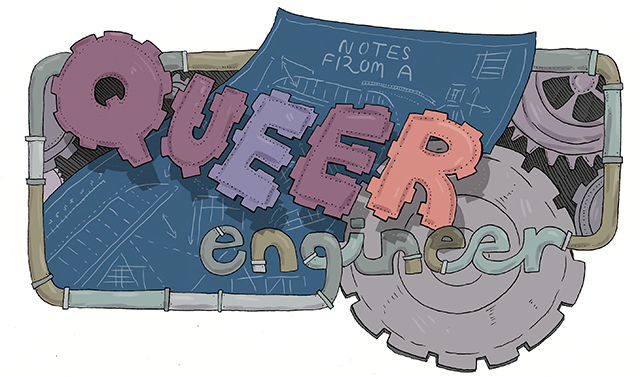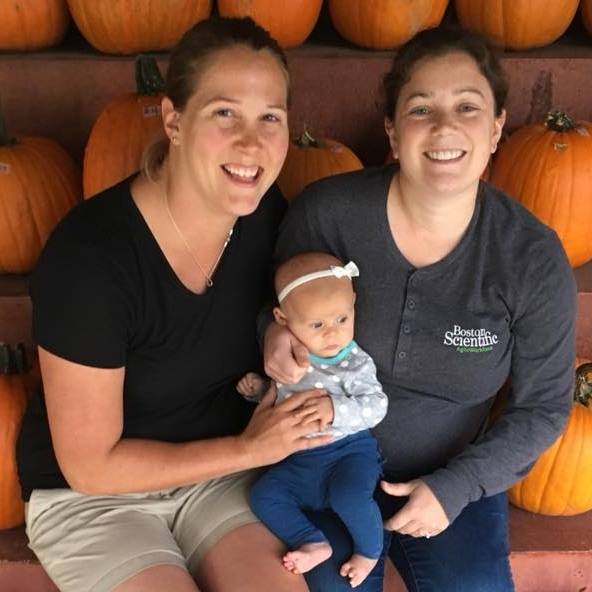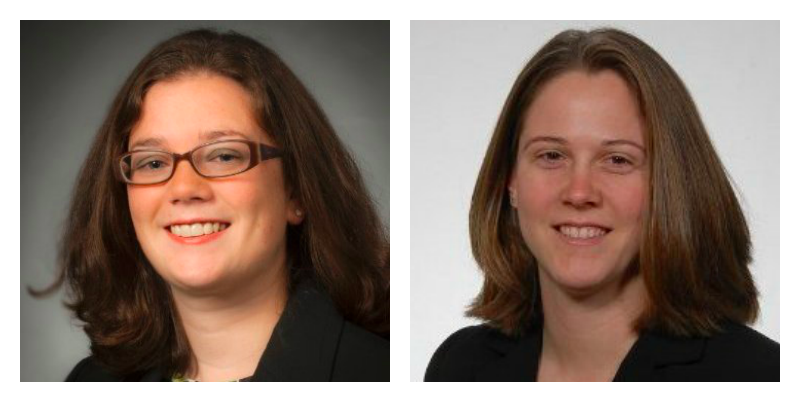 Header by Rory Midhani
Header by Rory Midhani
Hello pumpkins! How’s your week treating you? Last night my fiancée and I went out for after-dinner ice cream and bourbon and had a long discussion about career goals. We both work in STEM fields, and it’s just like, the best thing. I often find it weird to talk about my work stuff in queer spaces – not because my stuff is any more or less exciting than anyone else’s, but because there’s usually a huge income gap in the room. (A problem I suspect is linked to the systematic oppression of people in my network, specifically via the undervaluation of work associated with women. Thanks, patriarchy!) There’s a structural problem there, which I’m unlikely to solve as an individual, but one thing I’ve found helpful is to purposefully build a network of people who are willing to talk things out with me and compare perspectives.
My network includes my fiancée (obviously), and it also includes Kelly (who was in my undergrad engineering program) and her wife, Katie (another engineer, and a delight upon this earth). I visited them this weekend and had a chat with them about their careers, their move to Indiana, and how they stay connected with queer community.
Here’s Katie and Kelly.

Katie and Kelly with their three month old daughter.
Katie, what’s your engineering background?
Katie: Over the past 10 years I’ve done probably 10 different jobs at about 3 different companies. It spans operations and supply chain, mostly, with some quality engineer type roles as well. I worked for Toyota for about three years and did their rotational training program. I ended up in their purchasing engineering group, working with suppliers on supplier quality and acting as kind of an internal consultant pool for improvement projects.
Then after my wife and I moved to Boston, I worked for General Electric at their aircraft engine plant in Lynn, Massachusetts. I was a quality engineer there and then a production control specialist; I also worked as a supervisor during some of that time. And then I went to a different GE site in their oil and gas group and worked as a Lean leader there. They made oil valves.
There was a clear path forward at GE for me to kind of move on to the next management step, but when I looked five years ahead at what that would actually look like, it wasn’t the work-life balance I wanted. When I looked back the different roles I’d had and thought about what I liked the best and what I wanted to be doing, I really liked that Toyota role where I was traveling around and helping suppliers figure out how to do things better. I thought, if I could just do that, that would be a lot of fun. So that’s what I decided to do. Then I went back to get my MBA so that I would understand the business side of things a bit more – both in terms of running my own business, as well as consulting for people and being able to understand their business a little bit better too.
Now I have a little consulting group that’s just me. I consult part time on any kind of business process improvement. Right now I’m working with an HR group, so it’s very much off the manufacturing floor. I’m working with them to help their processes for recruitment and starting to think of that more as a process and what are the metrics they should be looking for and how do they do better at that.
Kelly, what’s your engineering background?
Kelly: I worked for three years at Raytheon in Andover, Massachusetts. I had a variety of roles there in manufacturing positions. I worked as a production supervisor, a new products lead, a production planner – a couple different things there. I left Raytheon when we came over to Indiana. I didn’t have a job when we moved here for Katie to go back to school but I found Boston Scientific and have been working there for about four years now as an industrial engineer. I hadn’t actually done an industrial engineering role after getting my industrial engineering degree, so I thought, well, let me try this!
It’s been good. As an industrial engineering supervisor, I work with pretty much everyone in the plant on process improvement – both on the manufacturing floor, but also in the office areas to improve their business processes.
How did your industrial engineering training help you – or not help you – in the earlier roles you held?
Kelly: It definitely helped me in all the roles I had at Raytheon where I was working with the manufacturing floor. IEs make great production supervisors if they have any inkling of wanting to lead people; it’s the perfect background for production supervisor. As a production planner I learned a lot about SAP – the technical side of it was more about learning about SAP and the system, how that all worked. But from a conceptual standpoint, having an IE background and understanding the need to plan material ahead and have a consistent flow of material and managing it in a smart way, all of those type of concepts came from my IE background. I think it helped me catch on quicker. Same thing for the new products lead. That one was more of a project management type role and it involved a lot of problem solving and change management, which were both part of my IE degree program. There are a lot of applicable concepts and tools in manufacturing operations.
Katie: One of the things I always say about what links these roles I’ve had is each one of them is problem solving. Each has been kind of a different way, a little different focus or whatnot, but everything has been problem solving. That’s what the engineering background prepared me for the most. It’s all problem solving, there’s just all these different tweaks.
Kelly: You know how to apply it to any different situation, any function. So really, hire industrial engineers! That’s the moral of the story.
Katie: On my LinkedIn profile, it says I’m a mechanical engineer by training, an industrial engineer by career, and a “common sense engineer” is what I call most of what I do. It just sort of ties it all together, that it’s all problem solving.
With such similar backgrounds, do you find yourself talking about work a lot when you get home? Do you help each other?
Kelly: Yes.
Katie: Yeah, and there was also that five month stint where Kelly and I both worked for Boston Scientific as industrial engineers in the same department.
Tell me about that.
Kelly: Well, we’re still married!
Katie: People still call Kelly “Katie” at work even this was like four years ago. But having the same last name, and first names that both start with K.
Kelly: We got asked if we were sisters.
Katie: Oh yeah.
Kelly: We got asked if we were sisters-in-law. Like we had brothers or something –
Katie: “Did you marry brothers?” That was interesting.
Kelly: That was probably the best one.
Katie: Like, no, we’re married to each other.
Kelly: They really couldn’t wrap their heads around us.
Katie: But yeah. That was a little intense at points, but it was also – I think we know how to work with each other really well, so it was really effective a lot of times. But it was also sort of like, okay, we’ve gotta take a break.
Kelly: Yeah, when we were working together, we didn’t talk about it at home.
Katie: Because you’ve already talked about it a lot at work. And we weren’t always together, but for a couple months, we were really working on the same stuff together.
Kelly: It’s a lot.
Katie: But we made some really good improvements in that area. And I think at the time, Kelly hadn’t led business process improvement stuff as much. I had done a little more in my last role as a Lean leader at GE, so I was able to show her how we had done it some there, and we kind of teamed together. Like I led the first couple of these and then she was like oh, okay, I see how you did it, and then made some of her own tweaks. I think it worked really well for the area. And at the time – I’m three years older than Kelly – at the time I was just a little bit more experienced in doing that. So I think it was sort of helpful to see how I did it, and then you made your own after that. You might disagree.
Kelly: I’d agree. It was helpful.

Kelly has a B.S. and M.E. in industrial and systems engineering from the Rochester Institute of Technology. Katie has a B.S. in mechanical engineering from Rose Hulman Institute of Technology and an MBA from Indiana University.
Katie: Kelly started in December and I came in like February. And the area was not in good shape. It was doing pretty badly, actually. They were on backorder to multiple customers. They were having trouble getting their arms around just what was going on in the area. And I think knowing that I was only there for a short period of time helped me stay really focused on what it was that I was supposed to do. Coming out of that, I think I was able to help get them on a much better path. It wasn’t just me, it was a team of people, of course – but I felt like I really made an impact and helped make some big steps forward in the direction they were going, as well as the actual status to customers and how well their machines were operating. And I can tell that it wasn’t just me who thought that because both of my consulting jobs that I’ve had since that time period were people that I tangentially worked with at Boston Scientific that went on to other places and then hired me as a consultant to come help them. And they’re people that weren’t even really that involved in what we were doing but saw what we were doing from outside and saw value in it and have brought me into their organizations.
That’s awesome. Kelly, can you tell me about something you’re proud of that you’ve worked on?
Kelly: I was able to work with the materials group – which includes receiving, shipping, warehouse, all the material logistics in the manufacturing plant and on the floor – and the operations group to put together a process flow we called “Build It.” It was basically the entire process flow of planning material, ordering material, inspecting it through incoming inspection with the quality group, delivering it to the floor with our material handlers, and building product. The point was to link together all the processes between those three different groups – materials, production, and quality – because on so many occasions, there was just not good communication between groups. People liked to point fingers and instead of fixing the flow all the way through the whole process, everybody just kind of wanted to look at their own metrics to see how they were doing. The exercise showed how everybody was interconnected and pointed out things like how planning effects production; changes to the production times changes how they can deliver material to the floor.
The project ended up getting a lot of good feedback from Boston Scientific leadership. There’s always a global conference they have for two days at the end of the year with all the VPs from the different manufacturing plants and supply chain organization. We were actually asked to present and it was one of the best practices they shared at that BSC global event. That was pretty cool. I think that it resonated with people because at the time, nobody had put it into a single process before and visualized it like that. We had the whole thing on the wall and each department had their own metrics. The intention was to make everyone think, how is what you’re doing effecting others? I think it opened people’s eyes to how they had to work together to solve these things.
And Kelly, you’re part of a GLBT group at work, correct?
Kelly: Yes, I’ve also been involved in GLBT employee resource groups. We had a GLBT alliance group at Raytheon that I was involved in; I was the treasurer for a couple years. And when I came to Boston Scientific, they had a similar group called PACE, which stands for people accepting and celebrating equality. It’s not my favorite acronym. It doesn’t make any sense and it doesn’t make any reference to GLBT people.
Katie: No one knows what it is until you explain it.
Kelly: We’ve started rebranding that with a tagline that includes GLBT so that people know what it is. But yes, I’m the site lead for PACE at the Spencer plant here in Indiana. We’ve been able to plan events and bring GLBT culture to the site and work with other leads at other sites across the globe. We do some workshops and bring speakers where we actually interact with each other and do a videoconference and everybody’s connected. It’s been nice to be able to do that at work and to have a company that’s very supportive of diversity as a value. They have definitely put their efforts to advancing different diversity causes and they do take it very seriously.
Is that something you worried about moving to Indiana from Boston?
Kelly: I definitely looked – we’re 100% on the HRC corporate equality index, and have been now for three years. That was something I looked for when picking a company. There’s so many of them now that I’d have to think twice about working for a company that isn’t 100%. Unless it’s like some small company that didn’t go through it. But if it’s a big company, if you’re not 100%? I’m just going to narrow you out.
There was a lot of stuff going in in Indiana when we moved here. They were actually about to pass an amendment to the Indiana state constitution banning same sex marriage, basically. Which takes years because you can’t do it in just one session, you have to do multiple sessions, and this was like the last round. But it came at a time when it ended up getting more attention and a grassroots effort helped to squash that successfully. I was involved with that. I pretty much worked there for four months before I got a job in Indiana. So yeah, that was kind of the environment I was coming to from Massachusetts, where you know, they’ve had marriage equality since 2005.
Katie: But we knew Indianapolis and Bloomington were safe, friendly, inclusive places for the most part.
Kelly: I told her if I’d move anywhere in Indiana it would have to be Bloomington. Like literally in Bloomington, you walk around and people have pride flags in windows year round. Bloomington is definitely the place to be for us.
Notes From A Queer Engineer is a recurring column with an expected periodicity of 14 days. The subject matter may not be explicitly queer, but the industrial engineer writing it sure is. This is a peek at the notes she’s been doodling in the margins.

This was really interesting. I would encourage you, Laura, to do more columns that focus on the specifics of various STEM and STEM related fields. I had no idea what an Industrial Engineer did and bet some of your young readers have never imagined work like this.
Request noted! Good suggestion. :)
Hard ditto! I didn’t know my job existed until I was an undergrad! (I’m an ecosystem ecologist/biogeochemist. Which, granted, is super weird job)
Thanks for this column! I’m also a queer lady in STEM, working in a male-dominated, not-so-progressive environment. I didn’t realize HRC had workplace ratings. That’s definitely something I’ll look for in the future.
This was the first time I’d heard about those ratings, too. Glad to share!
Really glad to see this column! I’m in school for engineering and trying to wrap my head around the jobs out there right now and what they entail. This is my first comment. :)
Yay! Welcome!
As an (aspiring) queer Engineer myself this was very interesting and cool, thank you!
So happy to hear that!
This is a well-timed article for me. I’m in Austin for the annual Society of Women Engineers (SWE) conference, and there quite a few panels and discussions about LGBT inclusion. There’s even a queer-friendly lounge called the Rainbow Room where you can pick up preferred pronoun stickers and little rainbow ribbons for your badge.
It’s always nice too see stories of what could be, and to know that I’m not alone in the queer engineering space through both SWE events and articles like these :)
I currently exist under the very nebulous “R&D engineer” title in the medical group of an open-source software company. So, i can end up working on anything on the intersection of medicine and programming. I usually go with “software engineer” when people ask me what I do since that’s the most easily explained portion of my work responsibilities.